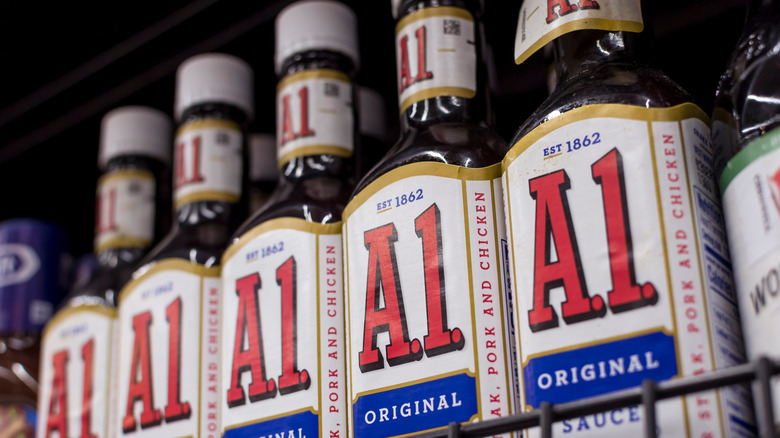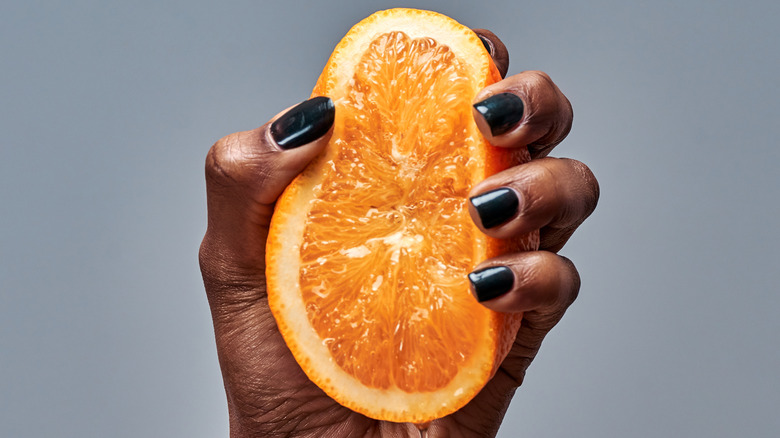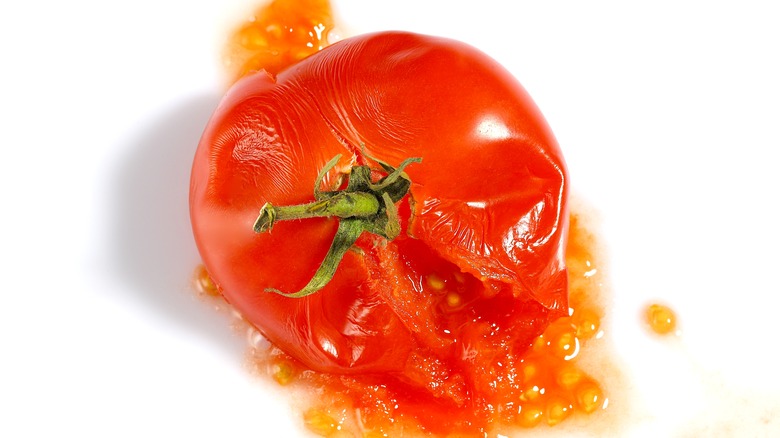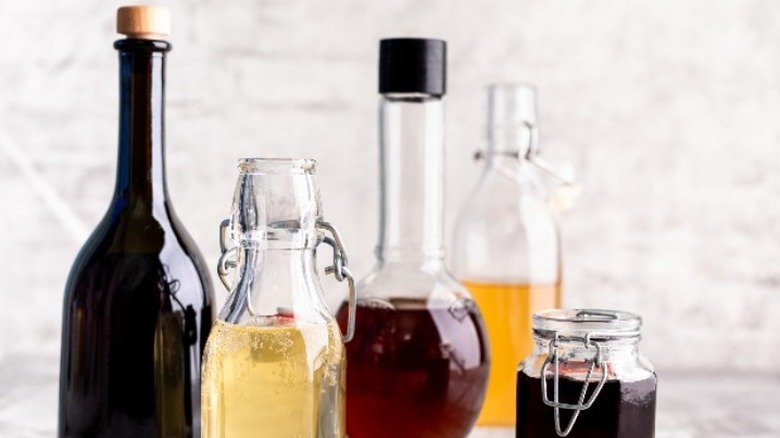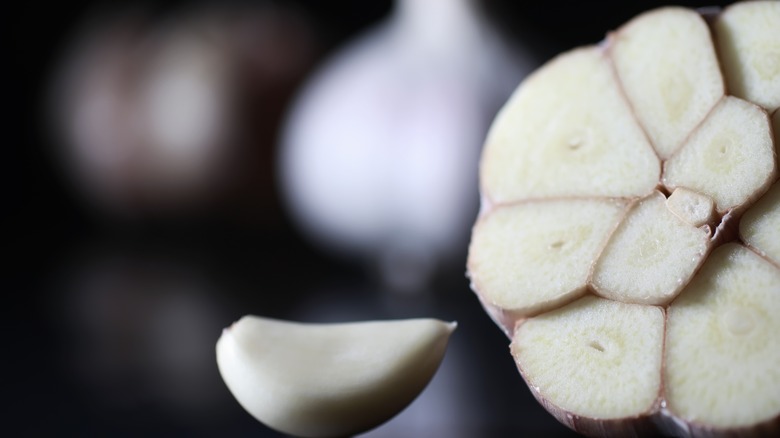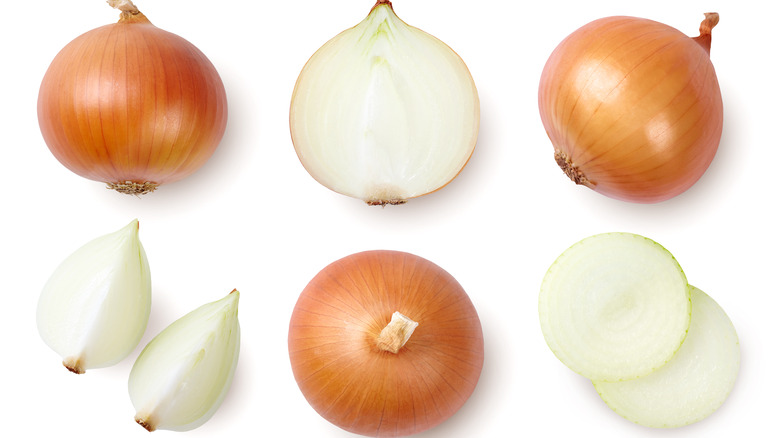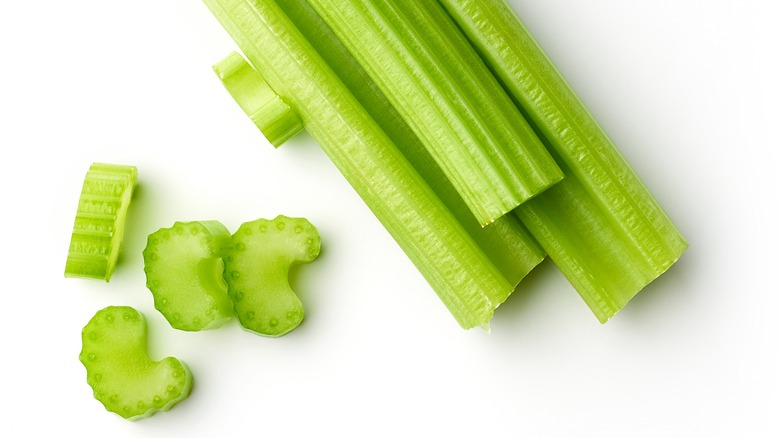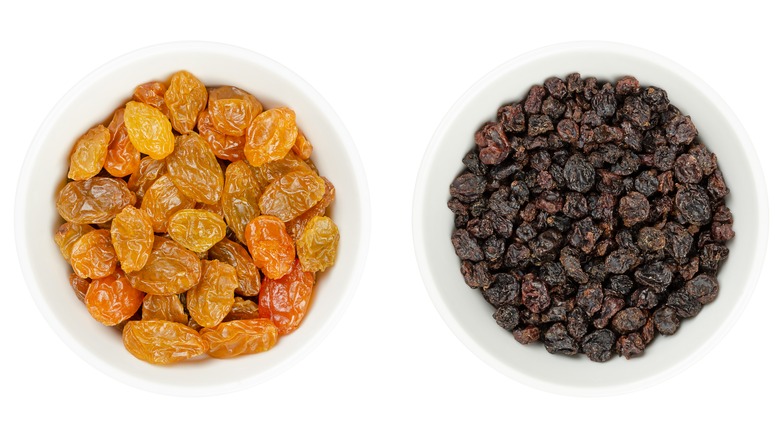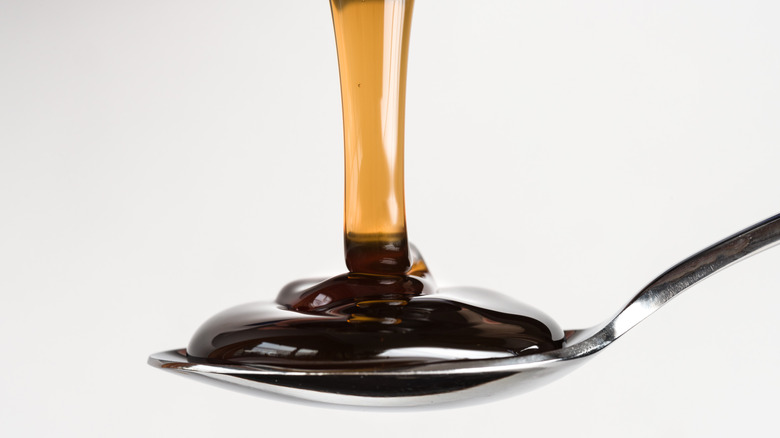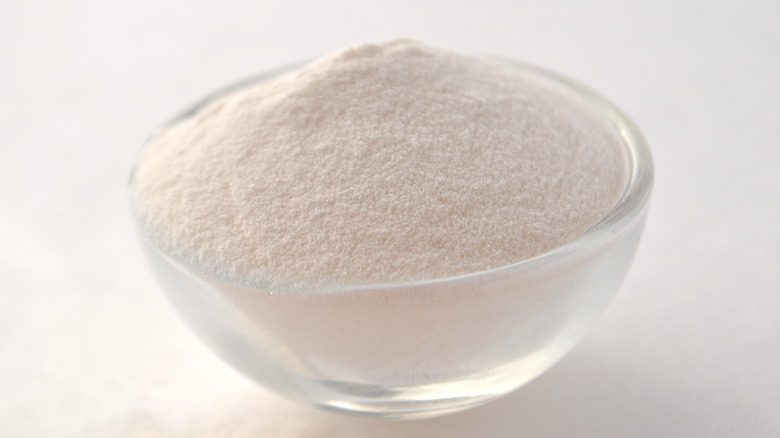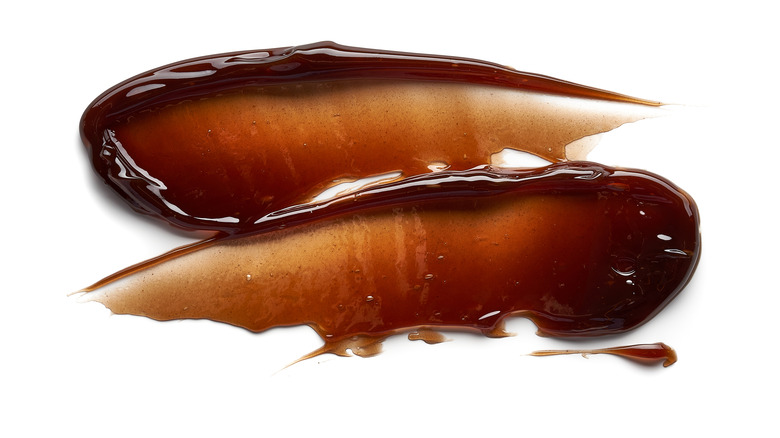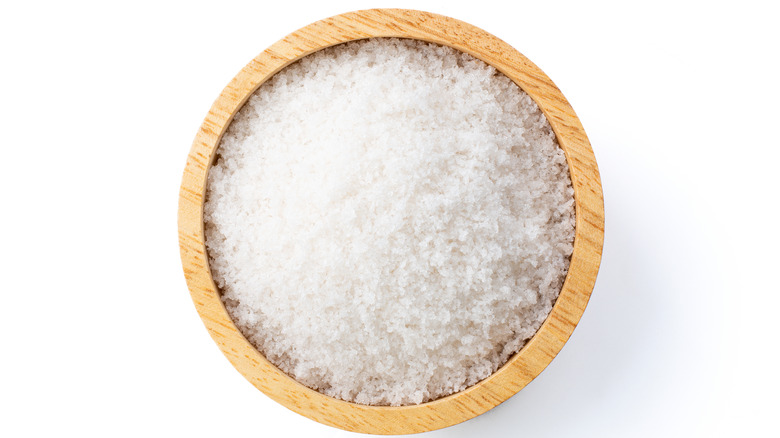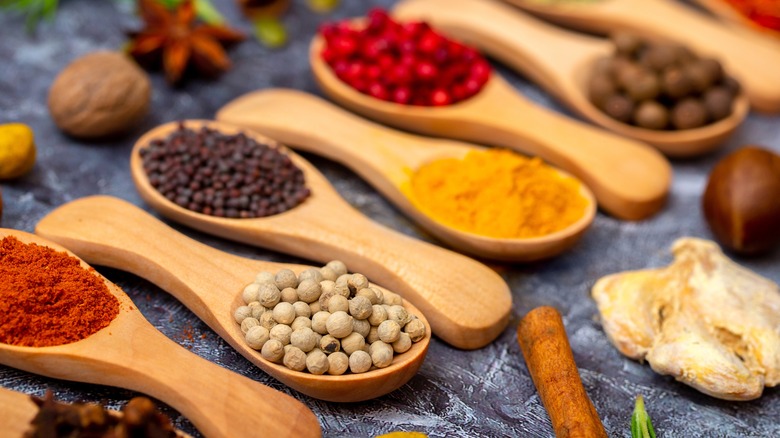This Is What Makes A.1. Steak Sauce So Delicious
We may receive a commission on purchases made from links.
The secret to A.1.'s tangy and lip-smacking flavor comes from its combination of acidic, sweet, savory, and salty ingredients. Of course, Kraft Heinz does not divulge all of the sauce's secrets on the label, so some speculation is also necessary. There are various flavors of A.1. sauce, but the original has been around since the early 1800s when royal chef Henderson William Brand created it for King George the IV (via Cook's Info).
While many of us know it as A.1. steak sauce, Kraft Heinz actually dropped the "steak" portion of the name back in 2014 to market it as more than just a condiment for steak (via Ad Age). Thanks to its perfectly balanced flavors, it deserves to be used beyond a basic dip for meat.
We will examine the top A.1. sauce ingredients to determine how each one contributes to making the sauce unique. Every component adds a flavor, textural, or chemical element that has helped the sauce endure as a favorite for nearly 200 years.
Crushed orange puree makes A.1. sauce tangier and meat softer
When you take the first bite of food slathered in original A.1. steak sauce, the tangy flavor makes your taste buds sing with happiness. You may be surprised to learn that one of the sources of A.1.'s zesty yumminess comes from crushed orange puree.
When Chef Henderson William Brand first invented A.1. sauce for King George IV in the early 1800s, the Royal Botanic Garden had its own orangery, which included numerous citrus trees. The types of oranges available in Europe at that time were bitter Seville oranges and sweet China oranges (via PB Works). Seville oranges are commonly used for marmalades and wines, while China oranges are popular for eating and juicing. It's unclear which type of oranges Chef Brand used, and the A.1. bottle label doesn't divulge the specifics either.
Depending on how they are incorporated, oranges add citrusy, fruity, floral, woodsy, bitter, and green notes to a dish. While the acidity in oranges can soften the surface of the meat, it tends to cause it to become mushy rather than tender if you leave the sauce in contact for too long (via Cook's Illustrated). So, you're best off using A.1. as a topping rather than as a marinade.
The taste of orange in A.1. sauce isn't obvious until you know it's there. But if you pay attention to the aftertaste, you'll realize that the citrus fruit is the final flavor that lingers on your tongue.
Tomatoes make A.1. sauce savory and sweet
At least 20 to 25 chemicals in tomatoes contribute to their flavor, according to a 2009 study published in the Journal of Experimental Botany. Among them, glutamic acid imparts an umami taste to foods like A.1. sauce. While you can find glutamic acid naturally in many foods like tomatoes, it's also produced commercially in a salt form that you may recognize: monosodium glutamate or MSG (via Science Direct).
This acid is responsible for making meat taste savory and meatier, which explains why meat and tomato sauce is so good. As tomatoes ripen, the glutamic acid increases, causing more umami flavor to be detected (via Umami Information Center). According to chef and author Samin Nosrat, acidic ingredients like tomatoes help tenderize meat by uncoiling the folded bundles of proteins through a process called denaturation. In fact, you may notice that the intense acids in A.1. "cook" the meat a little after you add them (via "Salt Fat Acid Heat").
The fibers in tomatoes also help thicken the sauce so that it doesn't run off your food as Worcestershire sauce does. So, you don't have to worry about the sauce mingling with other foods on your plate as much. The taste of tomatoes isn't obvious when you're eating A.1. steak sauce, but they still contribute to making it delicious. What's for sure is that the sauce certainly wouldn't be the same without them.
Vinegar is a natural meat tenderizer
Not only does vinegar add brightness to A.1. sauce, but it can help tenderize meat too, even if you only leave it on for a short time. While it won't penetrate deeply, it will break down the chemical structure of the protein on the surface of the meat to soften it (via Harvard Health).
The A.1. label doesn't indicate exactly which type of vinegar is in the sauce. However, previous versions of A.1. used malt vinegar, which comes from ale or malted barley grain (via Wired). There were eight vinegar manufacturers in London when Chef Henderson William Brand made his first batch of A.1. sauce for King George IV. Malt vinegar was one of the most popular types in England at the time, so it's a good guess for the original vinegar in A.1. (via Greater London Industrial Archeology Society).
When professional and home chefs try to recreate A.1. sauce, they typically use balsamic vinegar or a combination of balsamic and apple cider vinegar. Whereas malt vinegar has a sharp and sour taste, balsamic and apple cider impart sweeter notes to the sauce. Combined with orange puree, tomatoes, and raisins, the acidic notes in A.1. sauce really pack a punch. According to Samin Nosrat, acidic foods make our mouths water the most, which is closely tied in our minds with deliciousness and a desire to eat (via "Salt Fat Acid Heat").
Dried garlic helps meat taste more savory
Everything tastes better with garlic; it's also one of the ingredients that makes A.1. steak sauce so delicious. Allicin is a sulfurous compound that gives garlic its signature flavor. When you break down garlic cells by cutting or crushing them, a chemical reaction happens that creates allicin. The more you mince and crush garlic, the more allicin flavor you get. A.1. sauce contains dried garlic, which comes in a powdered form, ultimately bringing out a more intensely savory flavor in the garlic (via The Garlic Farm).
When you add a garlic-based sauce to meats, it combines with the sulfur-based compounds to highlight the meaty flavor (via Wired). In fact, garlic helps bring out the sulfur compounds in meat even more so than onions, simultaneously acting to mask bad odors or flavors in older or irradiated meat (via Meat Science). The garlic flavor in A.1. steak sauce is subtle, so you won't be left with the overwhelming taste in your mouth afterward. Instead, it simply enhances the overall flavor of the sauce and whatever you're serving it with.
Dried onion brings out a richer flavor in meat
When added to sauces like A.1., onion is another sulfur-containing allium that combines with the sulfur-based flavors in meats to make beef taste more flavorful (via Wired). The chemical that gives onions their strong flavor is isoalliin, and much like garlic, the more you cut into onions, the more they release this flavor-inducing chemical (via Cook's Illustrated).
If you have a cheap, lean piece of meat or one that is a little older and lacking flavor, adding a sauce with garlic and onions like A.1. will certainly improve the flavor and texture in a positive way (via Meat Science). A.1. sauce contains finely-ground dried onion powder, allowing the maximum amount of onion umami flavor to permeate the sauce. While the onion element doesn't overwhelm the overall taste, it still adds a deep richness to the sauce. Without onions, A.1. steak sauce wouldn't have the same level of complexity.
Celery makes A.1. taste better and keeps it safer
A surprising ingredient that makes A.1. steak sauce so delicious is celery. The vegetable can be overwhelming if it's not well-balanced, however, only a faint undercurrent of celery flavor can be detected, and only if you're making an effort to taste it.
We often think about acid, salt, and sugar as natural preservatives, but celery also has antioxidant, antimicrobial, and curing properties. It contains naturally-occurring nitrates, which help protect the growth of pathogens that cause food-related illnesses like botulism and listeria, according to a 2021 study published in Food Science of Animal Resources. If you've ever seen a restaurant keep A.1. sauce out on the table all day long, celery is one of the ingredients that keeps it safe to consume without continual refrigeration.
A few compounds in celery also help enhance sweetness and give food a more savory, umami flavor (via Science 2.0). Scientists think the smell of celery (more than the taste) brings out these elements in other foods. And if you smell A.1. sauce, you can definitely detect an undercurrent of celery scent. So, the celery in A.1. not only lends sweet and savory flavor notes and aromas to the sauce but also helps preserve and keep it safe. We guarantee the sauce wouldn't be the same without it.
Raisins deepen the flavor and prevent meat decay
An unexpected ingredient that makes A.1. steak sauce so delicious is raisins. According to America's Test Kitchen, raisins are the secret to a good steak sauce because they give it a depth of flavor you can't obtain from any other source. They also lend a candy-like sweetness and a tanginess to the overall flavor profile. Additionally, raisins are yet another ingredient that can help slow down meat decay thanks to their antioxidant content (via Portable Press). In the days before refrigeration when Chef Henderson William Brand first made his famous sauce, dousing meat with A.1. could keep it fresh longer and prevent it from tasting spoiled.
There's no indication in the ingredient list as to whether the raisins in A.1. are brown or golden. Per our observations, most homemade A.1. sauce recipes contain golden raisins. Harold McGee explains that golden raisins are treated with sulfur dioxide and dried at a specific humidity and temperature, which makes them taste lighter and fruitier (via "On Food and Cooking"). A.1. definitely has a fruity undercurrent, so Kraft Heinz may very well use golden raisins in its A.1. sauce.
If you're not a fan of raisins, don't worry about A.1. tasting like them because it simply doesn't. Nevertheless, while you can't taste them in the sauce, they work in harmony with the other ingredients to enhance the overall sweetness.
Corn syrup makes A.1. sauce sweeter and thicker
Although corn had made its way to Europe by the time Chef Brand was in the royal kitchen creating A.1. sauce, the method of processing corn syrup was only invented at the end of the 1800s (via Dr. Weil). As such, Brand wasn't using corn syrup to sweeten his recipe.
While raisins naturally sweeten the sauce, corn syrup elevates it to match American palates. That being said, A.1. sauce isn't as sweet as other meat sauces like barbecue or teriyaki. For some reason, Kraft Heinz decided to use corn syrup instead of molasses or sugar as we find in Worcestershire sauce. It could be because the raisins in the sauce already made it rich enough and corn syrup adds sweetness without much of a change in the overall flavor. Corn syrup (not to be confused with high fructose corn syrup) is undoubtedly an Americanized addition to a king-approved recipe that didn't really need any help.
Corn syrup is also a viscous liquid that provides a nice degree of texture and stickiness to the sauce. So, one of the reasons Kraft Heinz decided to add it may have been to improve the sauce's consistency.
Xanthan gum thickens A.1. sauce
Xanthan gum is another ingredient that we can assume didn't appear in the original A.1. sauce recipe. However, it seems to be yet another component added with the purpose of thickening the sauce. Contrary to its technical-sounding name, xanthan gum isn't a lab-produced chemical. It's actually a byproduct of cabbage fermentation. If you add glucose sugar to cabbage with a specific bacteria, the result is a white powder we know as xanthan gum (via Bob's Red Mill).
Xanthan gum helps to thicken and stabilize sauce ingredients, and the more powder you add, the thicker your sauce will be. Thanks to this characteristic, Kraft Heinz can adjust the level of xanthan gum to make its sauce the exact consistency it desires. While some other ingredients, like tomatoes, raisins, and corn syrup, thicken the sauce up a bit, the final texture can be adjusted based on the quantity of xanthan gum.
Since xanthan gum is flavorless, using it as a thickener instead of a traditional ingredient like flour allows all the other elements of the sauce to shine through rather than be muted (via Cook's Illustrated). You won't ever taste xanthan gum in A.1., but it's responsible for the perfect texture you've grown to love.
Caramel color gives A.1. sauce a more appealing hue
Caramel color works in unison with your brain to make A.1 sauce so delicious. A 2015 study published in Flavour found that color is the most important indicator of what we think food should taste like. Essentially, we're likely to have better associations with sauces that look the right color. If all the tomatoes in the sauce made it look like ketchup, you'd probably find A.1. less appealing by association. By adding caramel color, the final product is a subdued brown color.
According to color psychology, we have several positive associations with the color brown. For example, it's related to dependability, warmth, comfort, sophistication, and security (via Verywell Mind). On the other hand, the color red evokes danger, warning, excitement, energy, aggression, and dominance (via Verywell Mind). A.1. is definitely a dependable steak sauce since it has been around since the early 1800s. And, if you've been eating it on your steak since you were young, it's definitely considered to be comfort food. Our perception plays hand in hand with our sensations and that's abundantly clear here.
Salt enhances the flavor of food
You'll simultaneously taste and feel both sweet and salty flavors and sensations on your tongue when consuming A.1. This contrast — not unlike what makes salted caramel so popular – is another element that makes A.1. steak sauce so delicious.
According to author and chef Samin Nosrat, salt enhances flavor because it "unlocks many aromatic compounds in foods, making them readily available as we eat." It "helps release the flavor molecules that are bound up" in the proteins within ingredients in the sauce and whatever food you eat with it. Salt also helps to reduce how we perceive the bitterness in ingredients like crushed orange puree or vinegar by emphasizing non-bitter flavors like sweetness (via "Salt Fat Acid Heat").
If you're still unsure about the power of salt, consider the old fairy tale about a king who banishes his daughter because she tells him that she loves him as much as meat loves salt. She disguises herself to work as a cook in the royal kitchen, where one day she makes his favorite meat dish without salt. It tastes so terrible that the king demands to see the cook. The daughter reveals herself and says she cooked it to demonstrate how strong her love is; she loves him as much as meat loves salt. This fairy tale has had many incarnations throughout Europe, Pakistan, and India, making it no secret that salt is everything when it comes to making meat taste its best.
Other secret spices complete the flavor
No commercial sauce is without its secrets, and it's the secret spices that make A.1. steak sauce so delicious. The A.1. label lists generic "spices" among its ingredients. According to the U.S. Food and Drug Administration (FDA), "The term spice means any aromatic vegetable substance in the whole, broken, or ground form, except for those substances which have been traditionally regarded as foods, such as onions, garlic, and celery; whose significant function in food is seasoning rather than nutritional [...] from which no portion of any volatile oil or other flavoring principle has been removed." The governing body goes on to name 38 herbs and spices that can be labeled as "spices."
Chefs and home cooks who create homemade A.1. steak sauce recipes have speculated widely about the identity of the secret spices. Celebrity chef Alton Brown hypothesizes that it could be dried mushroom powder, allspice, white pepper, and anchovies (via Wired). Meanwhile, LA chef Josiah Citrin uses Dijon mustard, yellow mustard, button mushrooms, anchovies, tarragon, pepper, cloves, cinnamon, and cayenne pepper in his homemade A.1. steak sauce recipe. Several copycat A.1. recipes include Worcestershire sauce, which contains anchovies, cloves, tamarind extract, and chili pepper.
However, the only guesses from professional and home chefs that fit within the FDA definition of "spices" are mustard, allspice, white pepper, tarragon, pepper, cloves, cinnamon, cayenne pepper, and chili pepper. We have to conclude that those are the most likely contenders for the secret ingredients in A.1. sauce.
